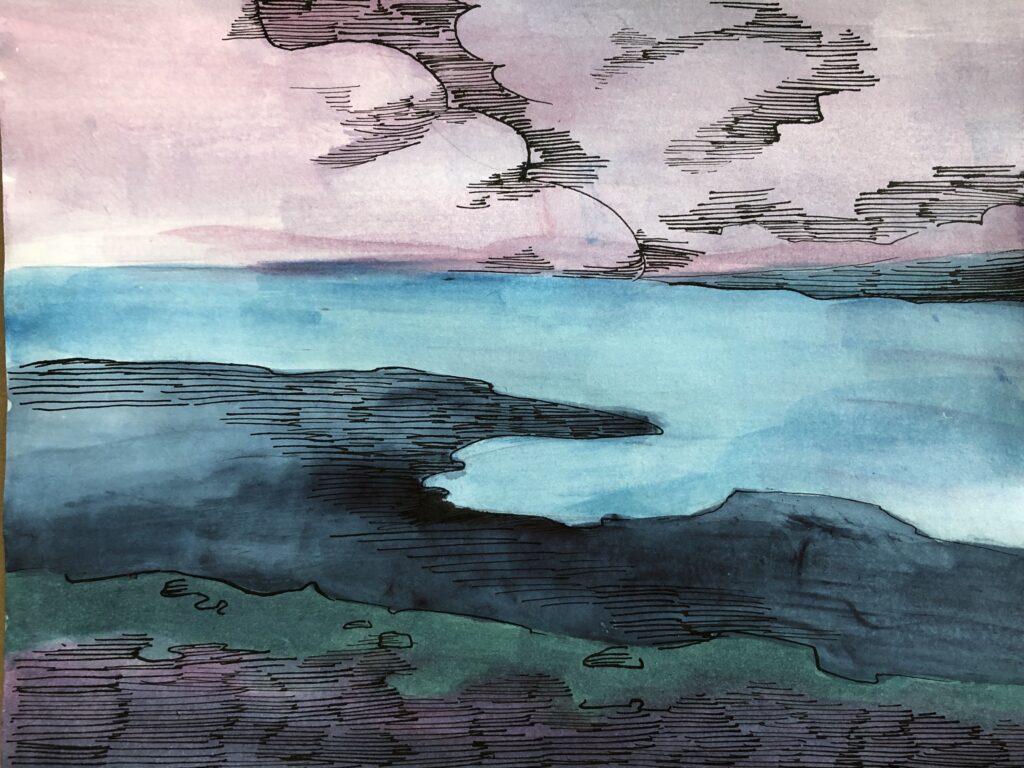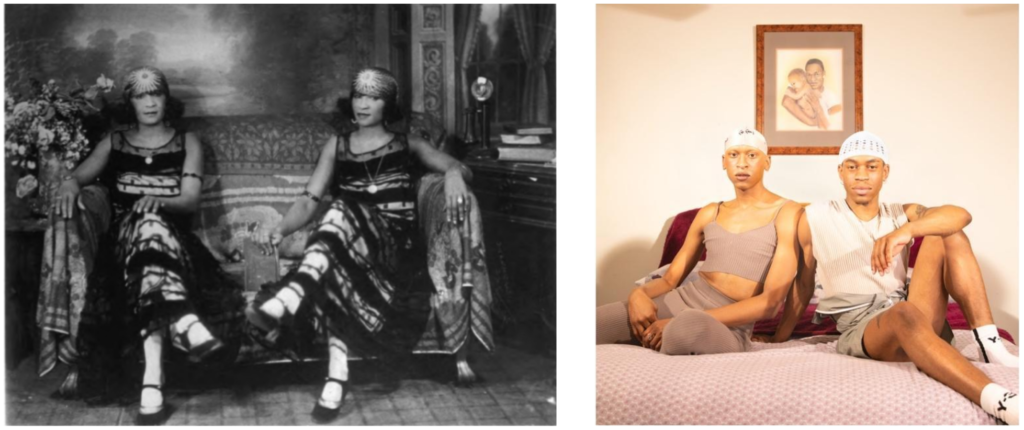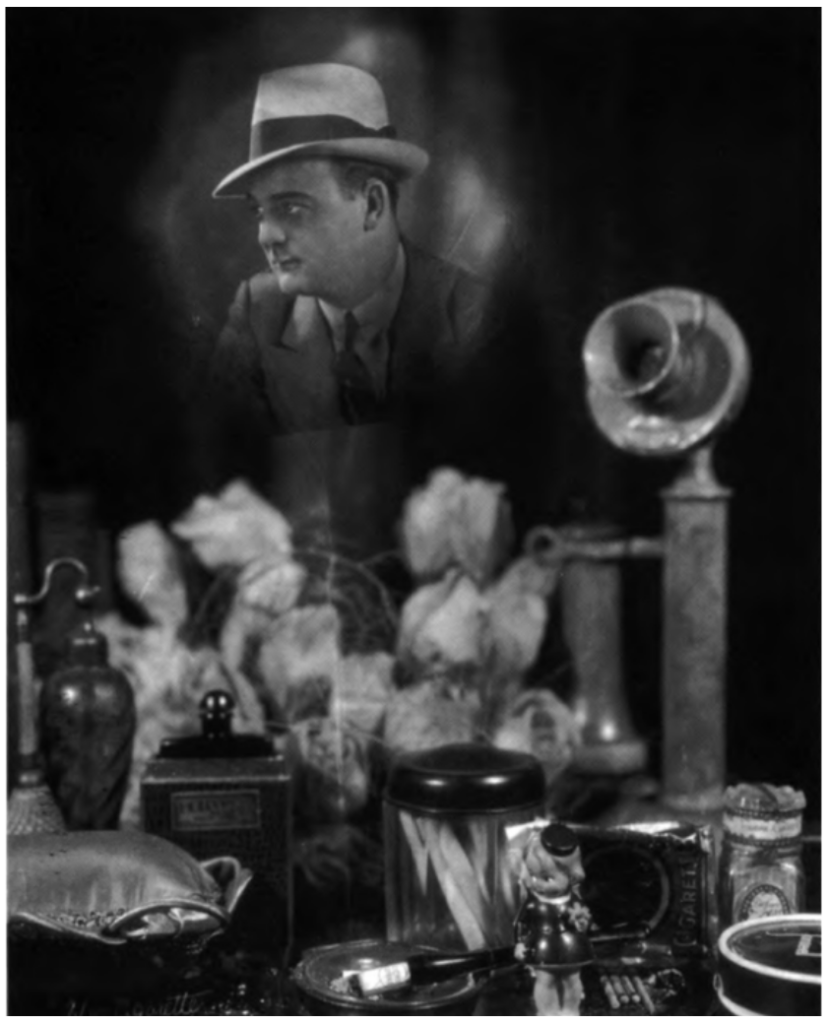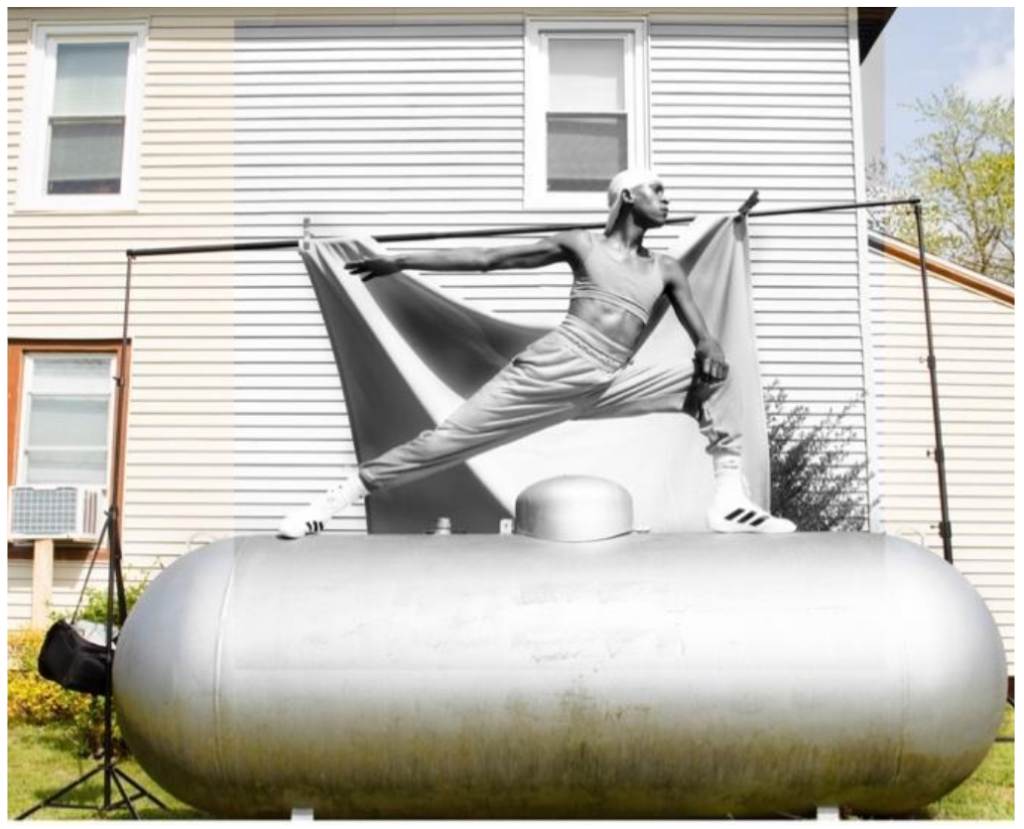The Queer Temporal Closeness of Photographic Works by James VanDerZee and Golden
by: Angie Lopez

Cover art by: Lulu M. Fleming-Benite (BC ’25)
James VanDerZee and Golden are two Black photographers whose work interrogates the construction of selfhood and community in order to inscribe the existence of an imperceptible, more liberated Black future into the present. VanDerZee worked during early and mid-20th century Harlem and is most known for the portraiture of Black middle class life and family that is central to his work. Golden is a contemporary Black gender-nonconforming trans-femme photographer, poet, and community organizer currently residing in Boston whose work similarly documents the intersection between Blackness and family within a more contemporary context, with a further integration of questions of gender (and its queerness) in his works.Though their artistic productions are isolated from each other by several decades, their works should nonetheless be considered in close conversation. To consider VanDerZee exclusively within the paradigmatic constraints of chrononormativity–the social construction of time as linear and progressive with the past, present, and future (Freeman 2010)–is to prevent readers from developing a full understanding of his work. Instead, his thoroughly modern approaches to photographic production and staging should be seen as a reflection of his desire to warp temporalities (Willis et Al. 1993). In this way, VanDerZee abides to a queer temporality, a temporality that is affective, non-linear, and corporeal, which allows his work to be in an active and reciprocal conversation with Golden’s work. I am basing my understanding of queer temporality and my research methodology on the work of American academic Carolyn Dinshaw who “imagine[s] temporality as queer…seeing [her] investment in “the possibility of touching across time, collapsing time through affective contact between marginalized people now and then… such queer historical touches…form[ing] communities across time. This refusal of linear historicism [opens up the possibility of] multiple temporalities in the present” (2007). I thus seek to affirm not only the ways in which the cultural impact of VanDerZee’s work affects the more recent works of Golden but also the ways in which Golden’s works can shed light on the ongoing project of utopic Black potentiality to which VanDerZee’s work contributes.
To bridge these two artists together through a queer understanding of time is to amplify their individual and collective beliefs in the playful potentiality of Utopia, specifically Black Utopic potentiality. Often seen as “something that is embraced at youth and abandoned at maturity” (Zamalin 2019), utopia is the investment in the transformative power of play and imagination, of potentiality unbridled by the constraints of reality. In utopia, there is a child-like wonder that, when pursued into adulthood, manifests in the cultivation of hope, which “embedded in this dream [of utopic thinking]… exists in the stuff of daydreams…where there exists the possibility of realizing a new beginning, a future to come, a society yet unrealized but transformative in its vision” (Zamalin 2019). To believe in utopic potentiality, to invest in the revolutionary pursuit of a future whose resonances remain unanticipated in the present, to believe in this transformative potential of the future, which, if understood through the lens of a queer temporality that blurs any discretenees between past, present, and future, can result in an equally revolutionary unraveling and reshaping of the past and the present (Munoz 2019). Additionally, potentiality can be the speculation of and the submission to unfulfilled desires just as much as it can be the anticipation of future fulfillment, for the centrality of desire, especially that which is not in the present, can positively disrupt the trajectory of desire in the future. After all, “queerness as utopian formation is a formation based on an economy of desire and desiring. This desire is always directed at that thing that is not yet here…moments that burn with anticipation and promise… past pleasures stave off the affective perils of the present while they enable a desire that is queer futurity’s core” (Munoz 2019). Utopic potentiality can be less about the fulfillment of desire as much as it is about the centrality of entertaining the desire, playing with the possibility of its tangibility, even if and especially when it is unreachable in the hopes of rendering a utopic future more possible.
Black utopic thinking specifically draws upon a lineage of Black utopic thinkers, with the first clearly identifiable one being Martin R Delaney. These thinkers formulated “new visions of collective life and racial identity. They outlined futuristic ways of being…They speculated on the ideal conditions for fulfilling human desire, while exploding its extant meanings” (Zamalin 2019). Particularly influential in the conceptualization of this specific project’s utopic vision are Samuel R. Delany’s utopic work Triton that articulates a “spirit of utopia in which freedom needs to embody a state of becoming” and W.E.B Du Bois’s work The Comet characterized by its “upending of the meaning of community.” According to Zamalin, “It became unformed and fluid, organized less around rational communication and realized objectives and more around the shared presence in the face of the unknown…Du Bois rendered [ ] intimacy speechless—as not confined by words, of a togetherness based in shared solitude, as a struggle to articulate rather than easily realize wants, communicate feelings, and listen” (Zamalin 2019). Delaney’s emphasis on the centrality of transformation evades coherence, stability and progressivism, and centralizes desire in the perpetual pursuit of transformation. Echoing Delaney, Du Bois’s conceptualization of community similarly valorizes the irrational, the queer, and the relationality of bodies untethered by language and brought together through more urgent means underscored by utopic idealism and desire-driven potentiality.
I am particularly interested in the pursuit of becoming as a state of being, with transformation existing as the root of both identity and change; furthermore, I am also curious about queerly constructed and sustained communities. Therefore, in this essay I draw upon the ideals of black utopic potentiality, as foregrounded by Delany and Du Bois, to position these two photographers in speculative intimacy. My pursuit is not a conventionally art historical one in which questions of provenance and influence take center stage; on the contrary, my pursuit is a playful, utopic one that disentangles these photographers’ works from the shackles of chrononormative restraints and returns them to an idealized state of intimate and revolutionary contact; it is to stage these photographers in a “moment[ ] of queer relational bliss” which has “the ability to rewrite a larger map of everyday life”. When I ground my visual analysis in both of these artist’s unique and interconnected gestures towards “future generations”, I mean to center their “[signals of] a queerness [and Blackness] to come, a way of being in the world that is glimpsed through reveries in a quotidian life… These future generations are…the invocation of a future collectivity, a queerness [and Blackness] that registers as the illumination of a horizon of existence” (Munoz 2019). To playfully place these photographers into conversation both with each other and with future generations is to embrace the revolutionary potential of connections across time and space that are rooted in utopic speculation, fantastical imagination, and transgressive searching of intimacy. If these two photographers’ works can be considered both in close contact and in direct connection to the construction of Black futurity, then the revolutionary potentiality of art and of play is undeniable.

To begin, it is worth considering Twin (2021) (fig.1) and Identical Twins (1924) (fig.2) by Golden and VanderZee respectively. Both of these works document a pair of twins and in doing so epitomize the relationship between these two photographers’ works. By drawing upon similar compositional and thematic elements in order to affirm the twins’ unions as having strong spiritual resonance, these works can themselves be considered twins, complementarily participating in the creation of an otherworldly Black spiritual identity that transgresses normative time. In engaging with questions of mysticism and parallelism, both photographers individually and collectively participate in the creation of a community that is similar to the one Du Bois outlined, rooted in the playful and utopic sharing of space and the communication with and about the unknowable. Spirituality in these works serves a medium through which the utopic potentiality of community and cross-temporal intimacy is achieved. In considering these works in conversation with each other through a playful approach to analysis untethered by constraints of chrononormativity allows for the auratic gravity of these works to emerge. VanDerZee’s Identical Twins features two women sitting on a furnished couch, with their legs crossed and pointing at each other, a book held up by the woman on the right taking on a central significance. Most notably, both women are dressed in the same robes and headscarves, wearing bracelets and bangles that equally mirror each other. Though scholars are quick to point to both the historical resonances of these accessories–the bangles connoting slavery and their garb connoting traditional African wear, and the historically specific resonances of modernity; the books seen as signs of Black cultural status, leisure time, and intellectual curiosity–it is only when the picture is considered in conjunction with Golden’s work that other compositional elements of the work begin to take new importance (Siddons 2013). In the ostensible foresight of Golden’s contemporary (re)iteration, it is the womens’ headscarves, adorned with a radiant sun, that begin to imply a psychic endowment that telepathically connects these women to each other and to the future. As Golden affirms in both the creation of their photograph and more prophetically in a written work of theirs, these twins become “omniscient / like light” (Golden, 2021). The iconography on these headscarves endows their posed asymmetry with nymphic playfulness, the tilt of the left-hand woman’s head with clairvoyant knowingness and the book held cryptically between them with prophetic charge. In this way, VanDerZee’s work does not simply construct a vision of Black modern identity rooted in both in acknowledgement of historical oppression and present bourgeois lavishes, but more pressingly it constructs a vision of a Black potentiality that playfully anticipates the future and moves beyond antiquated narratives of oppressions towards speculative, utopic imaginings of what is to come.
Golden’s work, Twin, as Identical Twins’s atemporal twin, is equally endowed with psychic affect. The straight-forward gazes, Golden’s on the left being slightly more vacant, more reflective, and their twin’s, on the right, more knowing, more anticipatory, visually parallels the gazes of the aforementioned women in VanDerZee’s work. It is as if these contemporary twins are also given the gift of temporal disruption, of futuristic anticipation and historic embodiment. In this contemporary work however, there are no books, no telephone, no prop indicating a lavish modernity, only a picture frame, depicting a Black parental figure holding a child that hovers above the pair of twins. If Golden’s work amplifies the prominence of the headscarves in VanDerZee’s, the consideration of VanDerZee’s work similarly amplifies the gravity of the painting in Golden’s work. That this rectangular form takes center-frame visually echoes the book in VanDerZee’s work and its depiction of nurture, enveloping them in an air of elder’s protection, activates the phantasmic presence, the unseen but spiritually felt imprint, of VanDerZee’s twins in this 21st century work. Golden’s twins become the future iterations of the baby in the frame, the centralization of their moment of nurturance serving as an acknowledgement of their linkage with a past that their currently bent knees, hanging wrists, and complementary asymmetry emulates. These twins are the futurity that VanDerZee’s twins anticipated. They do not, however, simply converse with the past; they equally co-create a Black futurity of potentiality, one that “exists…as an ideality that can be distilled from the past and used to imagine the future” (Munoz 2019). By choosing to close the gap between their bodies, as they have closed the gap between the past, the present and the future,they hold space for all temporalities with intimacy and resolution.
Despite the optimism in which both Twin photographs sketch potentiality, it is not always a task that lightens the future. On the contrary, works like Golden’s I just want to wear my orange dress to the tennis courts & come back home unbothered (2020) (fig.3) and VanDerZee’s Her Cigarette (Date Unknown) (fig.4) reveal that potentiality can be the speculation of and the submission to unfulfilled desires just as much as it can be the anticipation of future fulfillment, for the centrality of desire, as aforementioned, especially that which is not in the present, can positively disrupt the trajectory of desire in the future. Both of these works, in their use of photo-collage, assert the tantalizing omnipresence of impossible desire in which an alternative present is born. Despite desire’s inability to fulfill itself in real-time, it ruptures the present with the mark of possibility and is therefore a revolutionary act rooted in playful exploration. In Her Cigarette, VanDerZee depicts a still-life of a woman’s tabletop, cluttered with several items, including flowers and a telephone in the background, and cosmetic items in the foreground. At the center of the image is a lit cigarette in an ashtray whose smoke takes the form of a man’s portrait. This untraditional portrait anticipates the surreal manipulation of images for the creation of fictionalized photographic narratives by several decades and thus reflects VanDerZee’s queer interest in playing with photographic manipulation and documenting what “should be there” when it is absent (Willis et Al. 1993). By adding the cigarette smoke by hand and printing the portrait and the still-life simultaneously, VanDerZee created an image of desire that can only take form through surreal means; surrealism in this work being the material manifestation of the irrationality of playful utopic potentiality (Willis et Al. 1993). The cigarette acts as the ideal conduit to concretize the intangibility of the woman’s desire, through its intimacy with the woman’s lips, its consumption through heat, and its propensity to incite reflection in its consumer, is In manifesting the man’s image in its smoke, the cigarette represents the woman’s yearning for a man whose image is made visible but, like smoke, ephemeral. When considered alongside Golden’s work, a piece whose desire is not singular but politically charged with the social implications of marginalization, it becomes clear that the man’s image in smoke is indicative of romantic desire—however, this desire for a man is itself a reflection of her unachievable desire to adhere to conventions of desirability and femininity. Seeing as the cigarette is posed among cosmetic items, the yearning for attractiveness, desirability, and male attention beyond that of love, takes hold. The man is seen looking away, implying that, intrinsically, something about this woman does not attract the male gaze, so even when solicited imaginatively, it is always out of reach. Therefore, VanDerZee creates a representation of not simply of singularly unrequited love but more urgently of Dubois’s affirmation of socio-politically “feeling like a problem” (Du Bois 2005). Nonetheless, Vanderzee’s playful posing of this feeling, despite its unattainability in the present, infuses the future with the moment’s potentiality.
Golden pursues this sentiment through the exploration of the similarly unfulfillable desire of belonging, unbothered, to a public space as a gender non-conforming individual. Equally making use of photomontage, Golden creates a disjunctive image of themselves in which they superimpose an image of them wearing an orange dress and posing mid-swing with a tennis racket within the visible confines of an interior onto an image of an empty outdoor tennis court. The visible disjunction of these two images when considered alongside the image’s title speaks to the work’s centralization of the unfulfillable desire of existing as a gender-nonconforming individual in a public spaces with ease. Golden can only superimpose themselves onto the tennis court: fabricating themselves an indoor exterior, as indicated by the baby blue blanket behind them as a replacement for the sky. Unable to both wear a dress and be in public, to both playfully undermine binary understandings of gender and simultaneously participating in acts of leisure, they are confined to the safety and isolation of an interior space, their presence on the court taking on a phantasmic quality similar to the man’s portrait in VanDerZee’s work. The tennis court, like the cosmetic items in Her Cigarette, becomes embedded with an aspirational quality. It is easy to see how this piece constructs a potentiality that socio-politically confronts marginalization and challenges the erasure of gender-nonconformity through its candid representation of this public omission. This work is a potentiality of absence, of unfulfillment that is activated to imagine an alternative present one day achievable in the future. Like the cosmetics in VanDerZee’s work, the tennis court is a medium through which the unfulfillable desire, the desire to fulfillingly play, is made evident. When considering it in conversation with VanDerZee’s work, the traces of loneliness, of sentimentality additionally emerge and endow the socio-political project with intimate importance. In Golden’s work, their hand is open, palm facing up, gesturing upwards as one would do in order to throw a tennis ball into the air, or, alternatively, to solicit the hand of someone else. Thus, when Golden asks, in the work’s title, to “come back home unbothered,” they could either be aiming to play without disturbance but also, as implied in the ambiguity of their hand gesture and in conversation with the interpersonal urgency inscribed in Her Cigarette, seek to play in an accepting community (tennis after all, being a sport impossible to play alone). The potentiality of this work then does not simply remain a political commentary on the marginalized position of gender-nonconforming individuals but also acts as an intimate gesture motioning towards empathy-building among previously hostile parties. Both works inflect each other with meaning and intensify the urgency of the unfulfilled desire they each represent. They co-create alternatives to the present that, though doomed to remain normatively unfulfilled, nonetheless succeed in considering “problem of feeling like a problem as not simply an impasse but, instead, an opening” (Munoz, Ochieng’ Nyongó, and Chambers-Leston, 2020) in which innovative artistic techniques and utopic aspirations emerge.
Ultimately, the project of utopic Black potentiality that VanDerZee and Golden participate in is founded upon temporal multiplicity and photographic intervention. One last work to consider is Golden’s “I’m searching for & from freedom” (2021) (fig.5). Although this work does not have a historical equivalent produced by VanDerZee (in this way it is anticipating a future kindred piece still in works), it nonetheless participates in the creation of a queer temporality that collapses the discreteness of the past, the present, and the future in order to work towards the achievement of socio-political and artistic freedom while also centralizing the importance of photography in this pursuit. In this way, it is the artistic culmination of Golden and VanDerZee’s collective efforts to build a utopic Black potentiality. “I’m searching for & from freedom” (2021) depicts Golden in a high lunge facing the right of the composition, their right arm extended behind them. They are standing on top of a cylindrical metallic structure that is framed by a photographic backdrop stand holding up a draping cloth. The center of the image, which encompasses both Golden and the cloth, is in black and white while the periphery of the image, in which the exterior of a home is visible, is depicted in color. The temporal collapse of this work, its co-presence of the past and the future, in addition to its self-referential meta-inclusion of the art of photography, affirms the necessity of both photography as an art form and queer temporality as a paradigm in the construction of potentiality. The juxtaposition between black and white and color speaks to a co-existence of the past, as seen by the former, and the present, as seen by the latter, that affirms the existence of multiple temporalities in the present. This affirmation further allows for a closeness of the past and the future to emerge. Golden’s choice to depict themselves in black and white in conjunction with the title’s use of the words “for & from” suggest an intimate relationship between the past and the futurity building, or as Golden frames it, the searching for freedom, thus becomes a revolutionary act, in both senses of the word, a turning back and a complete, dramatic change(Freeman 2010). Freedom can be conceptualized both as a general socio-political freedom currently inaccessible to Black individuals but also, seeing the centrality of queer time in this work, a freedom specifically from chrononormativity, or the freedom from all the above, the freedom thus to engage in the meaningfully playful and utopic manipulation of time, space, and belonging.
Overall, James VanDerZee and Golden are two photographers whose intimate artistic connection overcomes the normative constraints of time. By inflecting each other’s work with new and dynamic meaning, they participate in an ongoing conversation about Black selfhood, community, and socio-political bearings. Despite working seventy years apart, they nonetheless participate in a collaborative generation of utopic potentiality that continually constructs an articulation of Black futurity. By collapsing the discreteness of the past, the present, and the future in their works and co-creation, they shed light on the radical freedom that queer temporal re-imagining can provide. In doing so, they construct a vision of the self and of the world that is rich with alternative explorations of temporality, desire, and closeness.
Works Cited:
Dinshaw, C., L. Edelman, R. A. Ferguson, C. Freccero, E. Freeman, J. Halberstam, A. Jagose, C. Nealon, and N. T. Hoang. “THEORIZING QUEER TEMPORALITIES: A Roundtable Discussion.” GLQ: A Journal of Lesbian and Gay Studies 13, no. 2–3 (January 1, 2007): 177–95. https://doi.org/10.1215/10642684-2006-030.
Freeman, Elizabeth. “Deep Lez.” In Time Binds. Duke University Press, 2010.
———. “Introduction.” In Time Binds, 1–19. Duke University Press, 2010. https://doi.org/10.1215/9780822393184-001.
GOLDEN. “Twin,” 2021, Hampton, VA. 2021. Works in Progress. https://www.goldengoldengolden.com/worksinprogress#e-23.
———. “AND I WILL ALWAYS BE YOUR MOTHER.” The Offing. , October 3, 2018. https://theoffingmag.com/poetry/and-i-will-always-be-your-mother/.
———. “Golden Reads Two Poems ‘TWIN’ and ‘XYXX.’” Great River Review, 2021. https://www.greatriverreview.com/issue-67-toc/golden.
———. I Just Want to Wear My Orange Dress to the Tennis Courts & Come Back Home Unbothered. 2020. Works in Progress. https://www.goldengoldengolden.com/worksinprogress#e-36.
———. I’m Searching for & from Freedom. 2021. Works in Progress. https://www.goldengoldengolden.com/worksinprogress#e-13.
José Esteban Muñoz. Cruising Utopia : The Then and There of Queer Futurity. New York: New York University Press, 2019.
José Esteban Muñoz, Tavia Amolo Ochieng’ Nyongó, and Joshua Takano Chambers-Letson. The Sense of Brown. Durham: Duke University Press, 2020.
Siddons, Louise. “African Past or American Present?: The Visual Eloquence of James VanDerZee’s Identical Twins.” African American Review 46, no. 2–3 (2013): 439–59. https://doi.org/10.1353/afa.2013.0073.
VanDerZee, James. Her Cigarette. n.d. VanDerZee, Photographer, 1886-1983.
———. Identical Twins. 1924. VanDerZee, Photographer, 1886-1983.
W E B Du Bois. The Souls of Black Folk. New York: Bantam Dell, 2005.
Willis, Deborah, James Van, Rodger C Birt, Beverly J Cox, Eric Himmel, Naomi Warner, Harry N Abrams, and National Portrait Gallery (Smithsonian Institution. VanDerZee, Photographer 1886-1983. New York: Harry N. Abrams, In Association With The National Portrait Gallery, Smithsonian Institution, 1993.


